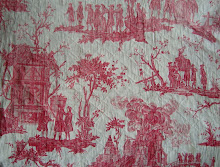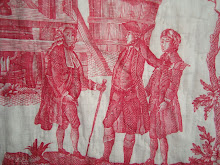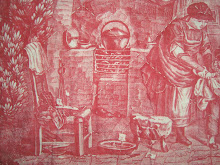







 I collected a large batch of late beautiful 18th century and early 19th century toiles this weekend, here are two fine examples of the latter.
I collected a large batch of late beautiful 18th century and early 19th century toiles this weekend, here are two fine examples of the latter.(Please click on each photo for supersize pictures)
The first piece is an beautiful example of a documented Toile de Jouy, but it has a different name in 2 of my books, firstly, it is called L'Oiseleur or The Bird Catcher dated 1811 in the book 'Toile de Jouy, Printed French Textiles in the Classic French Style' by Riffel, Rouart & Walter, but in 'Antique French Textiles for Designers' by June K Laval, it is called L'Abreuvoir or The Watering Place, and dated 1810. Interesting! A very fine textile, designed by Jouy's most celebrated artist, Jean-Baptiste Huet. I adore the expressions on the faces of the animals.
Now to the second piece, I have never seen this design or colour before, I was told it was The Labours of Hercules, but I am not so sure, there are only 2 vingettes, but 12 Labours. Of course, there may be more toile with the remaining labours printed on it that I haven't seen, but these 2 scenes don't seem to fit the descriptions of The Labours. It looks like a Toile de Nantes at first glance because of the layout of the design, but it is by an artist whose work I haven't seen before, the pictures are quite large, and beautifully designed, very classical, yet I don't think it is a Toile de Jouy, whose classical Toiles are very distinctive, as in the first example. I will have to do some research. Finally, the initials FP on the rock may be the artists or engraver's initials, so a clue to follow up!



















































































How fascinating...the initials on the rock. I love the colors of this toile and the first one I love the most because of the animals, always a draw for me. How hard it must be to choose. I too would want every single one. When I went to France some time ago with this quilt study group, everyone was so eager to find an original Jouy toile because we all seemed to find this the textile genre we all were captivated by. It is so amazing that you get your hands on such a wealth of history and originality. I would love to buy one or at least bid on one when you put them up if I can figure my way through the format of this. Thanks for sharing such beauty and rarity.
ReplyDeleteYou are very welcome. I sometimes feel a wee bit guilty at having so many beautiful textiles, I am just very lucky to be so near France, and even luckier that the French have hardly ever thrown textiles away, but stored them in attics and barns for hundreds of years! I hope you feel better soon, you made my day today with the arrival of the beautiful toile, so generous, and very treasured by me. A very special textile.xx
ReplyDeleteHi Lois,
ReplyDeleteI just discovered your blog. As a textile historian and afficionada I appreciate your spending time and effort to this wonderful blog. I have noticed that you have wondered about some of the images on the printed toiles you have collected. But I recognize this one, supposedly a 'Labor of Hercules'. This image is taken from a painting by the French painter J. L. David,titled The Oath of the Horatii, painted in 1784. Printed Toiles made in France and in England referred often to subjects in the contemporary popular culture. It is very likely that the production and marketing of this fabric had a political flavor.
It may be interesting for you to show some of your toile mysteries to an art historian familiar with the popular culture in the late 18th and 19th century. There are parallels between printed toiles and today's T-shirts.
Marijke K.
Thank you for your information Marijke, it makes sense with what I have been discovering about printed textiles of the period. I shall make a note of this, and use it in my research, many thanks agin, Lois xx
ReplyDelete